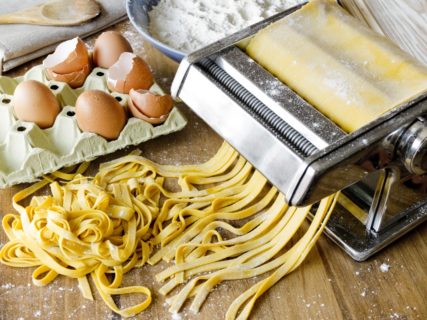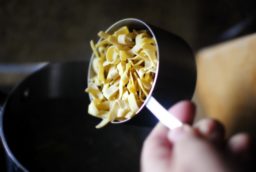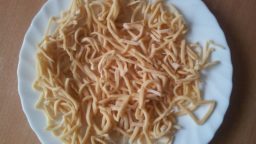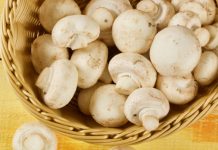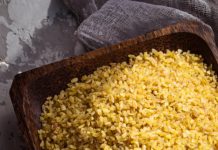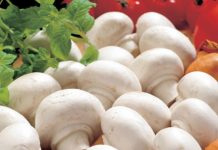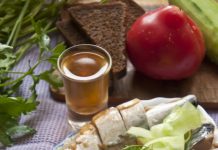Want to please your loved ones with delicious noodle soup? Knead it with your own hands! The recipe for homemade noodles on eggs is incredibly simple, and how much fun the result delivers! Cook a couple servings at once - the workpiece is perfectly stored and will be your lifesaver when you need to cook chicken soup, noodles with mushrooms, noodles in butter with greens and many other goodies. Having tried real homemade noodles once, your family will ask for it again and again.
Material Content:
Classic recipe
Homemade noodles are already good because they practically do not boil and retain their appearance, even if the soup cools down and stands still. Another significant plus is the transparency of the broth in which it is boiled. About how to knead the dough on homemade noodles and how to cook good and transparent soup like a tear, you will learn below.

So, the classic recipe is a combination of eggs, water, salt and flour. Eggs give taste, color and combine all the components of the dough. Flour is a building material, it can be the most ordinary, but sometimes for the greater usefulness of the product they put the flour of the first, and not the highest grade. Water makes the dough more malleable when rolling out, and for the same purpose, a little vegetable oil is often added. Salt gives flavor, but many recipes do not contain it at all. So this ingredient can not be used, but then you have to salt the broth well - noodles will take part of the salt.
For one medium saucepan of soup you will need noodles about as much as is obtained from such a set of products:
- 1 egg
- a couple of tablespoons of water;
- a pinch of salt;
- 150 g of flour.
With some dexterity, kneading the dough for homemade noodles is not difficult at all. All the subsequent options described in the article will be carried out according to the same kneading principle as this one, so we will tell you in detail.
- Combine water, salt and egg, mix with a fork.
- Pour the resulting liquid into the flour and mix well. Then hide the finished composition under the film for an hour.
- After this time, the liquid is completely absorbed into the flour. It is very important to thoroughly knead the dough so that it becomes smooth and even, not rough at break. A simple unleavened dough should be recovered in order to completely swell the gluten of the flour - this gives the necessary extensibility for the unleavened dough.
- Put the dough on a dusted board or table and roll out, sprinkling with flour. Do not be afraid to make the dough too dense, the more difficult it will be to roll out, the more noodles will be of high quality and indigestible.
- It is necessary to roll out the sheet as thinly as possible, to 0.5 mm thickness and even less. Then the sheet should lie down a little on the table. If you do a lot of dough, then you can hang the sheets to dry on the back of the chair, on the bar near the oven, etc. It is important to let the workpiece dry a little, then cutting it will be easier.
- The dough has dried. Screw it onto a rolling pin, take it out and flatten the resulting roll a little. You can cut it directly and obliquely. The latter method is good in that it gives longer strings of noodles, as many people like. The better and stronger the noodles are mixed, the more it is dried, the easier it is to cut it.
- Sliced products can only be tattered a little with your hands to disassemble the strips, after which they can be lowered into the broth.
To keep the broth clear, you can get rid of the flour by lowering the noodles for several seconds in boiling water. The flour is washed off - shift the workpiece into a pot with soup.
How to do without water
Very tasty egg noodles are obtained on eggs alone, without adding water. Working with such a test is a little more difficult - it is more difficult to knead and roll out, there is no such ease of stretching as with water. But if there is a desire, then everything will turn out.
To prepare a standard portion, you should take a spoonful of vegetable oil, one egg and flour, about three quarters of a glass. It should be noted that a simple noodle dough is very fond of flour, therefore, kneading from the indicated volume, you will still fill it up when rolling.
This is just the case when the flour does not harm, but helps the cause.
Mesim is the same as in the first recipe for the classic version of noodles. The only difference is that more time and effort will be spent on kneading and rolling.
These products will make noodles twice. You can put the residue in a dry place and dry for storage.
Cooking using milk
You can make dough from any flour and from any liquid. In this case, the liquid can be both eggs and milk, sour cream or whey. The general condition is that liquids should be taken in half as much as flour, and in the process of kneading, add flour.

Knowing this proportion, you can improvise by adding milk or any other dairy product to the eggs. And you can do without eggs at all, combining, say, 75 ml of milk, a whisper of salt and 200 flour. In this case, milk and salt are mixed, and then this mixture is added to the flour. If you put eggs in milk, then, accordingly, you need to increase the amount of flour.
There is not much difference in the batch, but there is one caveat: the dough, kneaded in milk, is perfect for noodles on a side dish. If you plan to use it only as a backfill in soup, then milk will give clouding of the broth. Therefore, it is better to cook soup noodles yet only on water and eggs.
Egg noodles for soup
Homemade noodles for soup can become more original if you add different seasonings and spices to the usual ingredients. So, noodles with the addition of turmeric will have a nice yellow color.
And here is another interesting recipe:
- Take an egg, a glass of flour, a couple of tablespoons of cold water, half a teaspoon of salt and the same amount of paprika.
- In a high bowl, make a slide of sifted flour and in it a depression.
- Beat in an egg, water and pour salt with paprika.
- Knead and continue kneading until smooth.
- On a table sprinkled with flour, roll and cut the noodles as thin as possible.
Useful tips for housewives
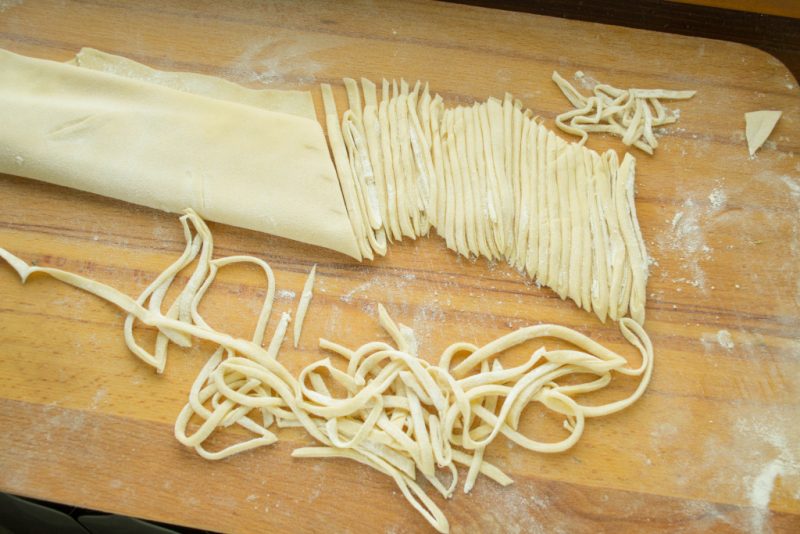
- You can diversify the taste and color of noodles with natural dyes and additives. So, spinach juice will give a greenish color, you will tint the product with pink beetroot juice, and saffron will give an orange-yellow tint.
- For long-term storage, dried noodles need to be transferred to a clean and dry paper bag or tin box. A fresh linen bag is also suitable.
- If you are rolling out the dough on a special noodle cutter, in no case add salt. Crystals that are not dissolved in the eggs will ruin the glossy shafts of the machine!
- Boil the noodles for a short time, just a few minutes. Overcooked, it will lose in taste and appearance, so it’s better not to finish it. In a hot broth, noodles will still reach the desired softness.
Calorie Noodles on Eggs
Usually noodles are made from eggs, hard flour and water. What is the calorie content of such a product?
100 g of noodles contain 322 kilocalories. Moreover, if you remove the yolk from the composition, the dish will become dietary, as the fat content and content of yolk cholesterol will decrease. Adding juices instead of water will slightly increase calories, but will make noodles more saturated with nutrients.








